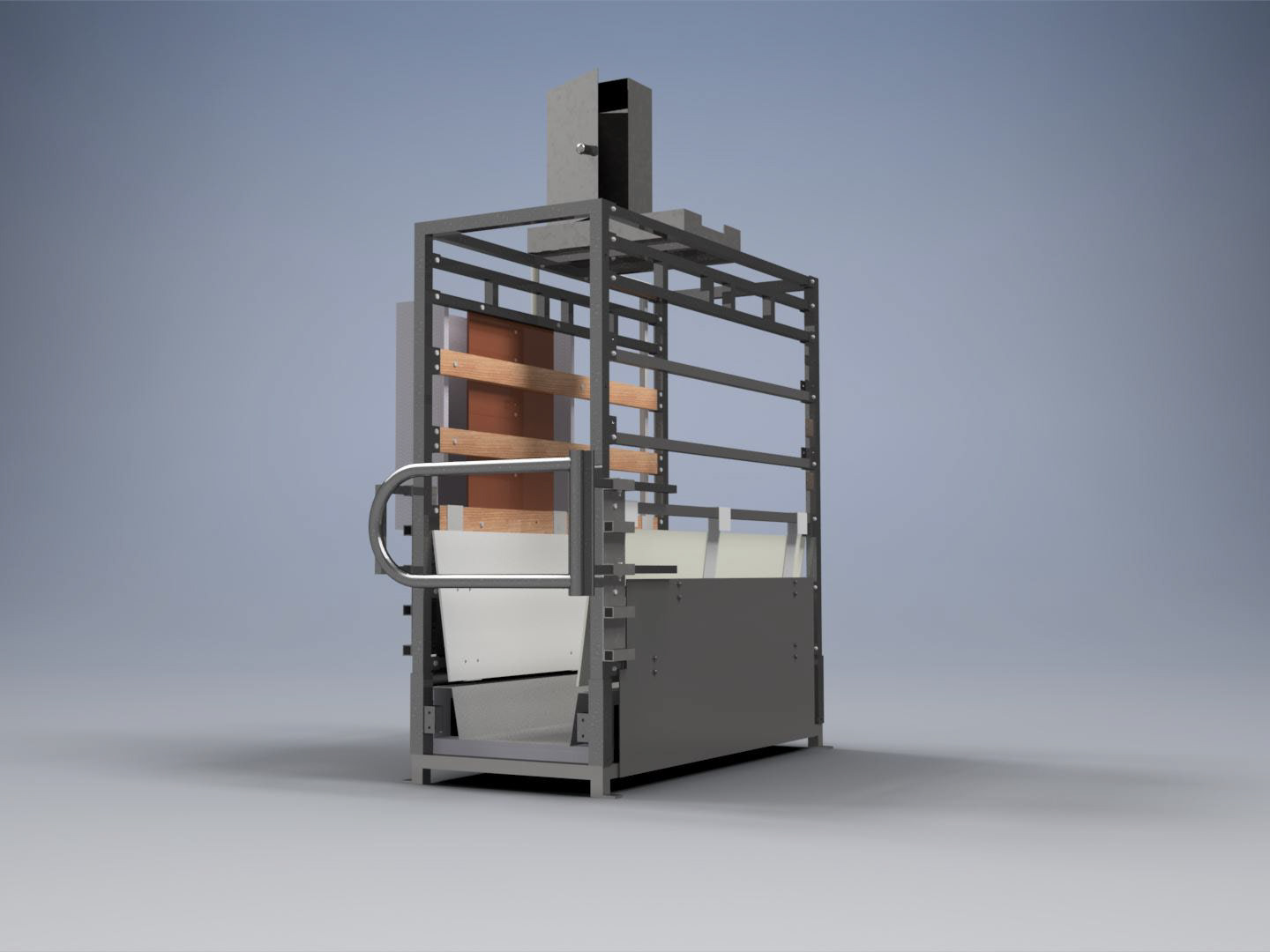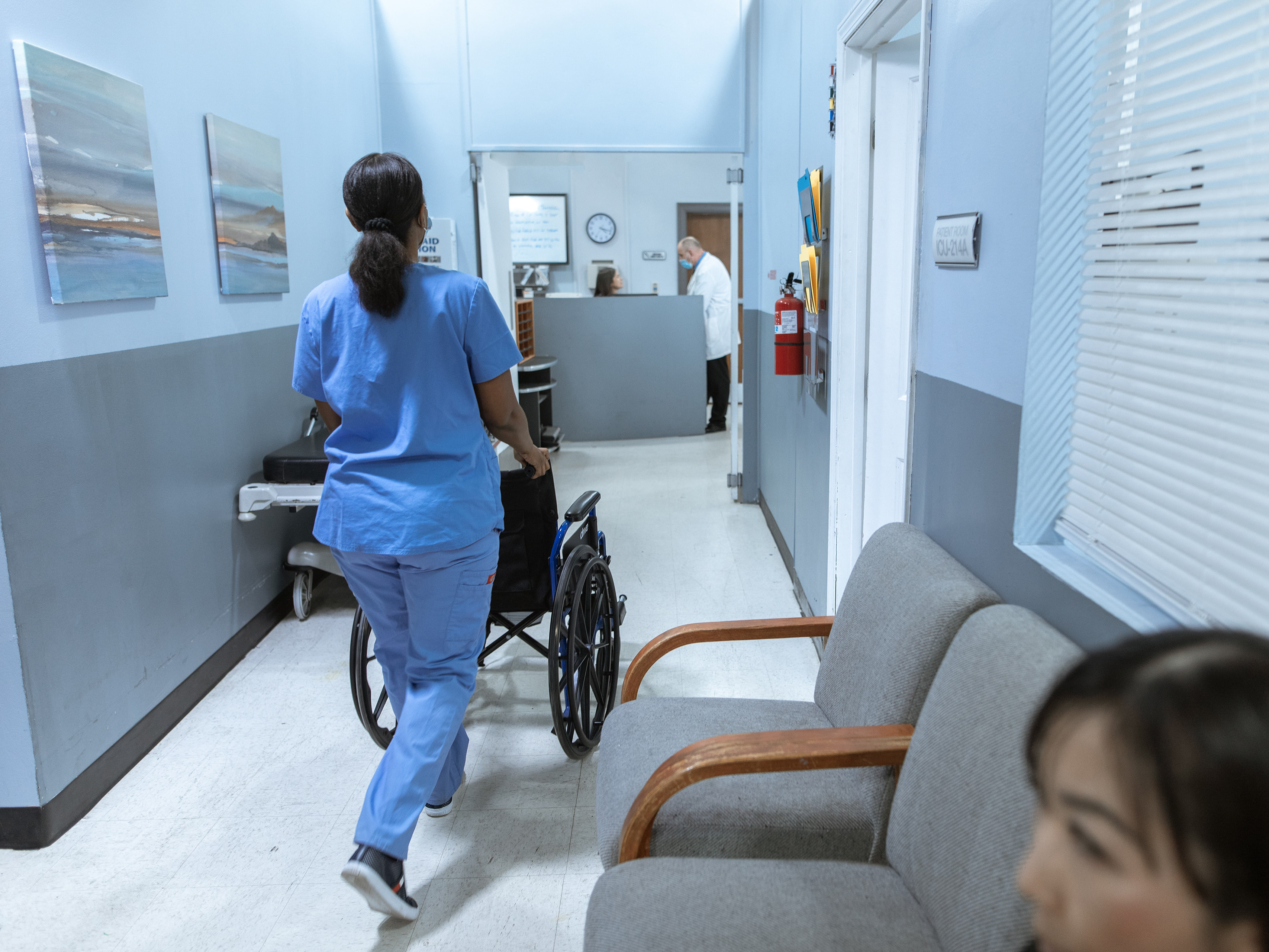Duration: 16 weeks
Team
Anna Skoglund
Estela Marie Ankarbåge
Magdalena Johnson
Cecilia Henje
Kristina Videberger
Team
Anna Skoglund
Estela Marie Ankarbåge
Magdalena Johnson
Cecilia Henje
Kristina Videberger
THE CHALLENGE
Gothenburg City wanted to improve their bus stops in connection to the debut of an electric bus added to the public transit system. We focused on developing the bus stop for big groups with leaders, and specifically groups of young children (in day care). Young children are impulsive and have less awareness of traffic and therefore create a danger both to themselves and other road-users. Today's Gothenburgian bus stops are not adjusted for these type of users which creates a stress for day care teachers. The choice of target group was relevant since the new electric bus route would be in an area where children could visit museums, a science centre, an amusement park, the city library, etc.
Gothenburg City wanted to improve their bus stops in connection to the debut of an electric bus added to the public transit system. We focused on developing the bus stop for big groups with leaders, and specifically groups of young children (in day care). Young children are impulsive and have less awareness of traffic and therefore create a danger both to themselves and other road-users. Today's Gothenburgian bus stops are not adjusted for these type of users which creates a stress for day care teachers. The choice of target group was relevant since the new electric bus route would be in an area where children could visit museums, a science centre, an amusement park, the city library, etc.
This project is divided into two phases. The first phase focused on identifying the user needs through observations and interviews. For the second phase, the team is split into two teams and each team creates their own solution based on the same identified user needs.
MY ROLE
I helped design the interview template, transcribe the interviews, formulated the needs, prioritized the needs
I helped design the interview template, transcribe the interviews, formulated the needs, prioritized the needs
Gaining perspective
We contacted schools who were most likely to use the route to see if and when they would use public transit, and focused on the layout of inner city bus stops. To start gathering knowledge, we aimed to conduct both hidden and open observations in the natural environment. The purpose of hidden observations was to not affect the users' actions (since they'd be aware of their actions being analyzed). Three observers placed themselves at different locations around the same bus stop. In total, five groups were observed.
A couple of the observations turned into unstructured interviews to get a deeper understanding of the leaders' behaviors, feelings and opinions about traveling. We also arranged two semi-structured interviews outside the natural environment with adults who had experience in leading groups. Assuming that the leaders didn't tend to think about how the bus stops are designed, we instead asked them to describe the latest time they led a group of children in public transit.
KEY TAKE AWAYS
One of my favourite methods to categorize large amounts of soft data is the KJ-method. It is a method where you (relatively) quickly can get your data organized making it easier to process and turn into clear user needs, with just using sticky notes. We managed to find three main areas based on the input from observations and interviews.
Quotes from the interviews.
Safety
It became obvious that traveling with several kids is stressful for leaders who have to make sure that no one gets lost and that each child listens to their instructions. Considering the high amount of stress, a trip to the library can quickly turn into a negative experience for the leaders which may affect the safety. During a trip a leader has to be in control of crossing streets, making sure all the children are in line, not getting too close to traffic, buss or tram transfers, counting the children and ensure that each child gets on and off the vehicle safely (which sometimes includes lifting the children).
It became obvious that traveling with several kids is stressful for leaders who have to make sure that no one gets lost and that each child listens to their instructions. Considering the high amount of stress, a trip to the library can quickly turn into a negative experience for the leaders which may affect the safety. During a trip a leader has to be in control of crossing streets, making sure all the children are in line, not getting too close to traffic, buss or tram transfers, counting the children and ensure that each child gets on and off the vehicle safely (which sometimes includes lifting the children).
MENTAL AND Physical relief
Many of the needs in this category have a close relationship with those in "SAFETY". Fulfilling the safety needs would also fulfill many of the mental relief needs for the leaders. We also saw that the leaders are in need of quick information to avoid that their focus shifts too much from the children. The information could be about bus/tram times, what direction to walk, where the transfer is, etc. A specific physical relief for the target group could be to facilitate getting children on and off the buses or trams and decrease the need of lifting children.
Many of the needs in this category have a close relationship with those in "SAFETY". Fulfilling the safety needs would also fulfill many of the mental relief needs for the leaders. We also saw that the leaders are in need of quick information to avoid that their focus shifts too much from the children. The information could be about bus/tram times, what direction to walk, where the transfer is, etc. A specific physical relief for the target group could be to facilitate getting children on and off the buses or trams and decrease the need of lifting children.
Learning stimulation
Sometimes the children had to wait 15 minutes which is a long time for a child. The leaders could give them some fruit to snack on or, find a topic or object (like a poster in the bus shelter) to talk about. This facilitated the leaders' job since it unified the kids' focus toward one subject, and hopefully stop them from running around too much.
Sometimes the children had to wait 15 minutes which is a long time for a child. The leaders could give them some fruit to snack on or, find a topic or object (like a poster in the bus shelter) to talk about. This facilitated the leaders' job since it unified the kids' focus toward one subject, and hopefully stop them from running around too much.
Formulating needs
From the data analysis we defined two categories of needs; needs for the general public transit rider and needs for our target group. Below are the needs for the latter. We also identified each need according to the KANO-model where you identify how a service's or product's attributes affects its attractiveness and performance at the same time. You have "must-haves" (M), "wants" (W), and "exciters" (E), and if there is a lack of any of these type of attributes it may affect the users' satisfaction.
Transportation between transfers should be able to be executed in a safe way for both leaders (M) and children (W)
The group should be able to get on and off the vehicle in a safe way (W)
The group should be able to gather with ease when waiting for the vehicle or after exiting the vehicle. (W)
The bus shelter should provide stimulating objects (E)
The bus shelter should offer opportunities to facilitate an overview of all group members (E)
The bus shelter should provide a geographical overview of where they are (E)
The group should be able to get on and off the vehicle in a safe way (W)
The group should be able to gather with ease when waiting for the vehicle or after exiting the vehicle. (W)
The bus shelter should provide stimulating objects (E)
The bus shelter should offer opportunities to facilitate an overview of all group members (E)
The bus shelter should provide a geographical overview of where they are (E)
Creating
From the user need study we found several important needs - but as we felt that we couldn't fulfill all needs in one product we chose to focus on a few of them: facilitate gathering and overview, and provide some type of mental stimulation. These needs seemed to be applicable directly at the bus shelter while the other needs included other areas we didn't have any control over. We also wanted our solution to tolerate the Gothenburg climate, some damage, be easy to repair and switch parts, not be attractive to thieves, tolerate high usage frequency, reflect ElectriCity's values and be intuitive.
At this point of the project we were divided into groups of 2-3 people. This meant that our original group was became two groups who would both create their own product/service based on the same user study.
In most projects I am in charge of creating hand drawn sketches.
Based on our observations and interviews, we created a primary and secondary persona. Maria, 35, is our primary persona and represents a leader who guides younger children through public transit. Freddy, 5, represents the children. At this stage we started to use our personas Maria and Freddy more and made up the same scenario but from their own each perspective to enhance the differences of their experience of traveling in public transit. Building these personas helped the team members to get on the same page of the target group's experiences.
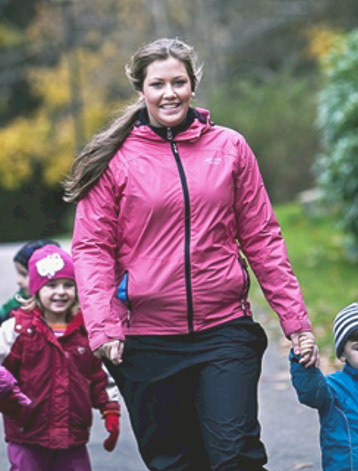

Expression & Inspiration
This expression board helped us define how we wanted the users to experience the product. The back pack is the character; colourful, functional and practical. As a metaphor, we chose a kitchen aid; it is self driven, reliable, and helpful. For form and material, we chose the trash can and door knob respectively. These objects were chosen to reflect the purpose of the product.
To start the idea generation we wrote down words that we associated to each user need we wanted to fulfill. I drew the mind maps below for us to get a better overview.


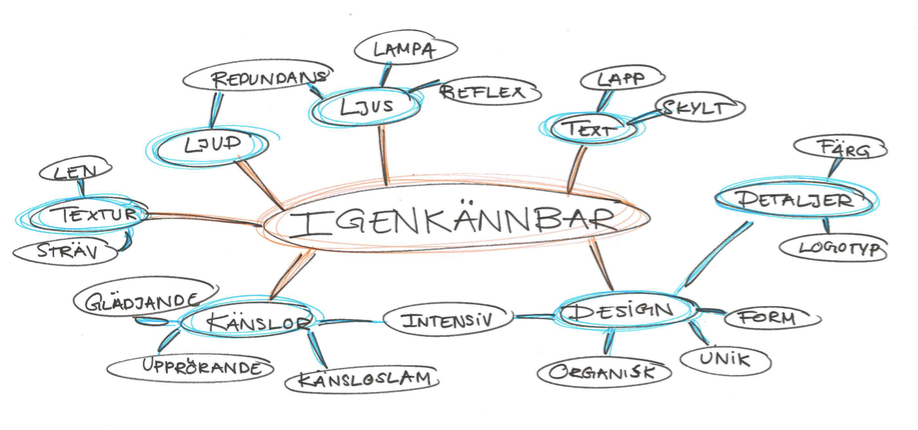
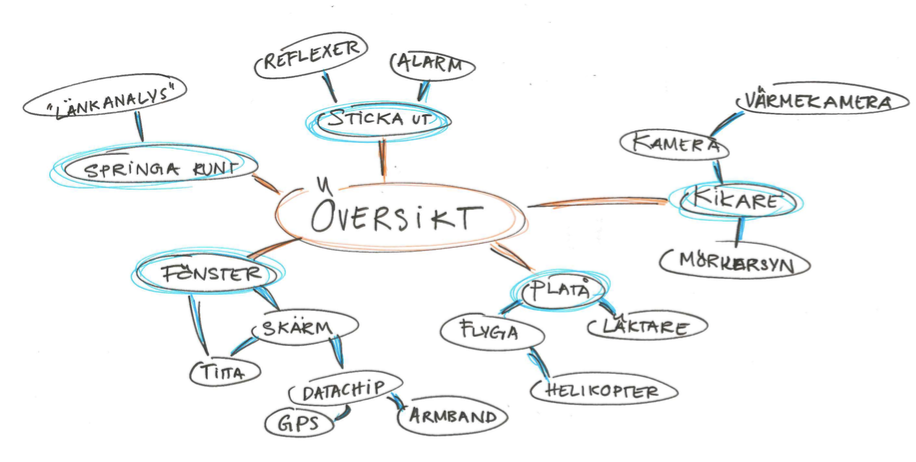
Concepts
The ideas were developed by making both small and life size models to get a feeling of the proportions. This helped us adjust the measurements according to our target group. Based on feedback from the class and our own multi-criteria analysis we chose to continue with concept one - it fulfilled the highly prioritized needs best out of the three concepts.
I created sketches for both concept one and two, however, I could only recover sketches for concept two.
Concept one
An interactive "fence" which could function as a gathering spot. When applying pressure to the fence, it starts a light sequence. The fence is also connected to a screen (which is one of the bus shelter's walls) where another light show starts. It is supposed to give a playful expression with both shape and colours which would attract children to interact with it.
Concept two
relocating the shelter's walls would create more safe places for the group to gather. The walls would be in glas to give an overview of the group. On one of the walls would be an interactive map of the area, and on another wall would be a puzzle that the children could interact with.
Concept Three
This app would help keep track of the children so the leaders would feel less stressed when using the public transit. The app would be combined with GPS-bracelets for the children. Each bracelet would also have a game to make the children enticed to wear the bracelet and avoid them taking it off.
Developing Concept One
The development included looking into suitable materials, measurements, technology and colours. At first we played around with big paper rolls and tape rolls to get a feeling of what measurements we would like. To make manufacturing, installation, and repair simple, we decided to go for a maximum of three sizes for both the globes and the pipes. The reason to have several sizes is to create a playful impression as suggested in the Expression Board.
We built a CAD-model in Autodesk Alias where we played around with the shape. Here, the concept includes many angles which would complicate the manufacturing process. The final look was a straight line to avoid such complications.
Inspiration board for materials.
The light play would start when someone touched any of the pipes. How it could look like is demonstrated in a video of a tribar below and a video created in After Effects.
A technology we imagined could work would be something that would create a magnetic field which sensed when a hand touched a pipe.
The product would be installed close to a bus shelter and would get it's electricity from a nearby electrical cabinet.
We visualized how the connecting parts inside the "globes" could look like, as well as where to install the screws and the parting line.



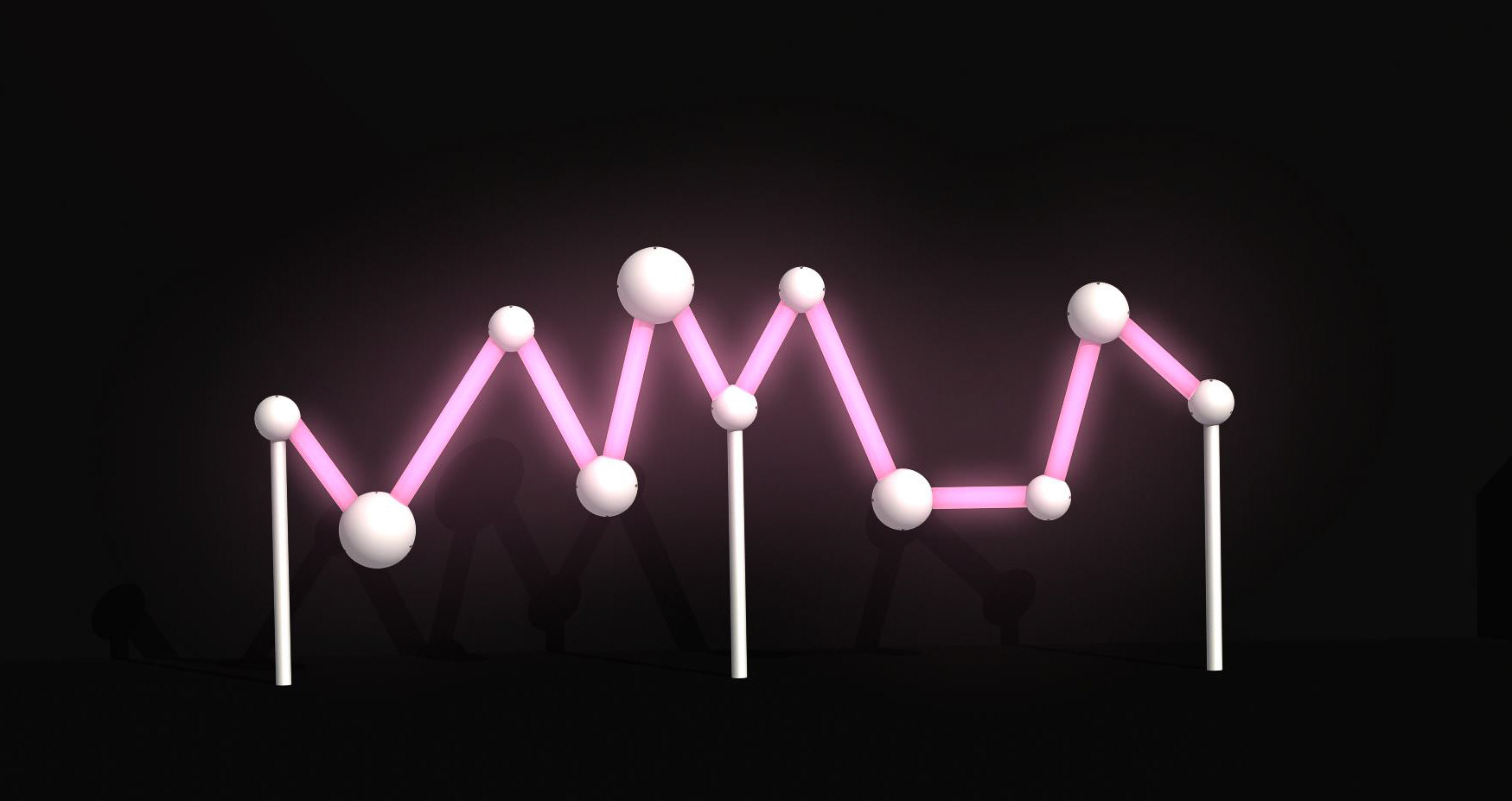
Reflections
The first phase was very focused on finding our target group's needs which included a lot of interaction with the users, however, I wish we used user feedback more during the concept creation. We didn't check which concept they preferred or what they thought about the final concept product.
